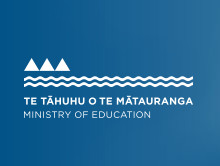I Muri i te Pānui Pukapuka
After Reading
Ka taea te whakamahi ēnei ngohe hei aromatawai, hei whakawhānui hoki i ngā pūkenga o ngā ākonga.
Possible assessment and extension activities.
1. Akiakina ngā ākonga ki te matapaki i ngā pātai nei:
- He aha ngā akoranga matua ka mau i a koe i tēnei pukapuka?
- He aha ngā pātai i tuhia e koe i mua i tō pānui i te pukapuka nei? Kua whakautua āu pātai?
Mehemea kāore he whakautu pātai rānei, mā tētahi atu huarahi te whakautu e kimi, arā, i te whare pukapuka, i te Ipurangi, i ōu whanaunga rānei.
Get students to discuss the following questions:
- What are the main things you have learned by reading this book?
- What were the questions you wrote before you read the book? Have your questions been answered? If not, try and find some answers in another way, try the library, the Internet, or perhaps ask family.
2. Me tautohu ngā tauira o te reo whakaahua i roto i te pukapuka, ka whakamārama atu ki ngā ākonga ka pēhea tēnei reo e āwhina ai i te kaipānui ki te whai atu i te whakaaro o te kaituhi. Hei tāpiri atu, me whakamārama ka pēhea te whakamahi i te reo whakaahua e whakarite kia pārekareka ai te reo tuhi. Tuhia he pūrongo e whakamārama ana i ēnei āhuatanga.
Identify the descriptive text in the book and talk to the students about how they help the reader identify with the feelings of the writer. You could also talk about how the use of descriptive language makes writing sound more interesting. Write a report outlining how and why this occurs.
He hokinga whakamuri hei kōkiringa whakamua
Ideas for reflecting in learning and planning next learning steps
1. Kia rangahau ngā ākonga i ētahi ōritenga, i ētahi rerekētanga hoki i waenganui i te oranga o ngā tāngata i te wā 1800 me te oranga o ngā tāngata i tēnei wā.
Encourage students to research other similarities and differences between how people lived in the 1800’s and how they live now.
2. Kia uiui ngā ākonga i ō rātou koroua, i ō rātou kuia rānei mō ngā āhuatanga o ia rā i a rātou e tamariki ana. Kātahi ka whakaatu hei whaikōrero, hei whakaaturanga ā-hiko rānei.
Get students to interview either their koro or kuia about what daily life was like for them as children. They then present their information either as a speech or a computerised presentation.
3. Ohia manomano me ngā ākonga te kerēme a te imi Moriori kua whakatakotoria ki te Rōpū Whakamana i te Tiriti.
Discuss with the students the claim the Moriori people have lodged with the Waitangi Tribunal.



